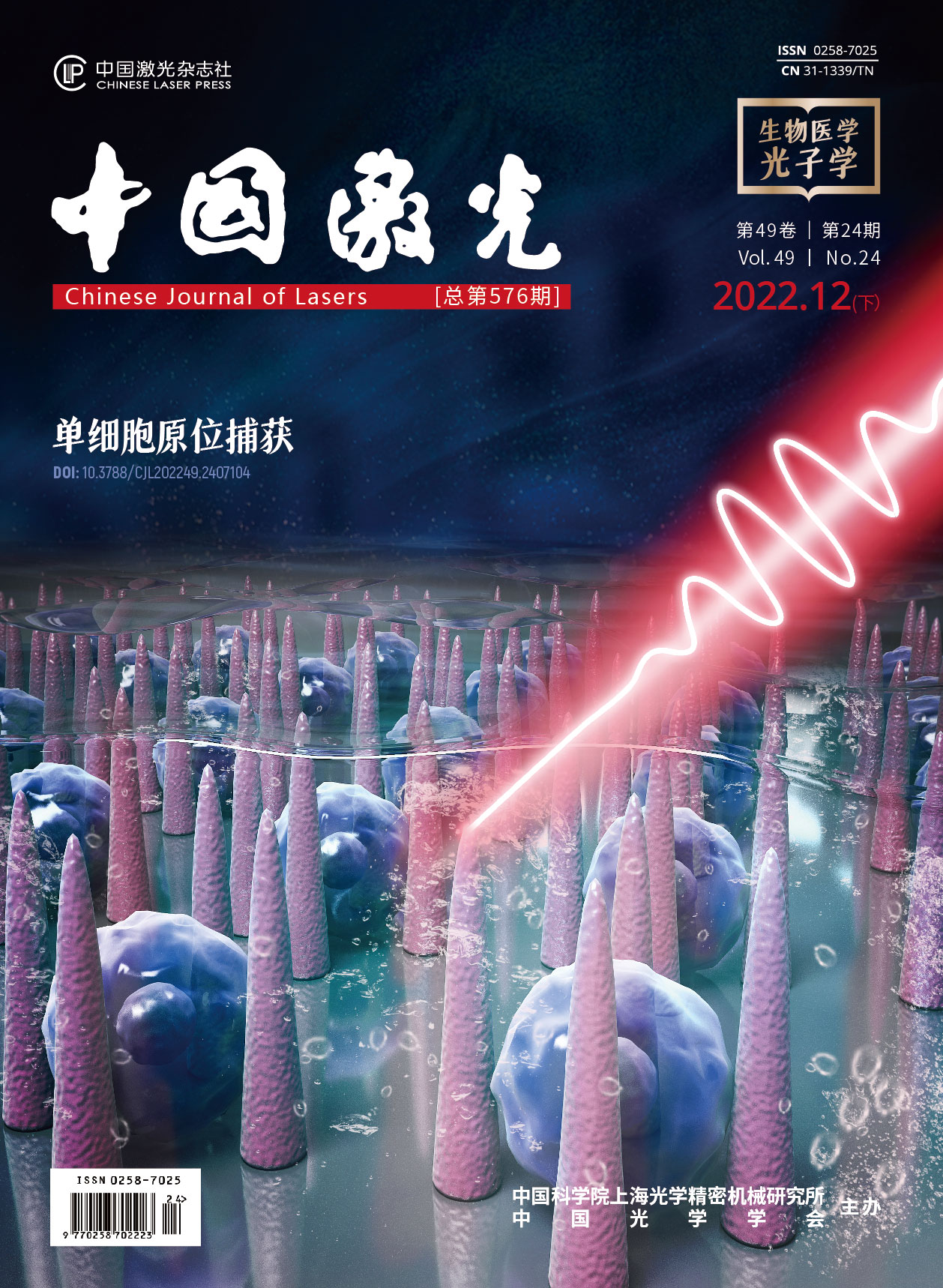平行平面腔光学参量振荡器失谐特性实验研究  下载: 727次
下载: 727次
Optical parametric oscillators(OPOs)have been proven to be effective,coherent light sources that can expand the wavelengths of commercial lasers(typically limited to narrow emission lines and bands)to a broad range from visible to far-infraredbands. Q-switched lasers with high peak powers have significantly promoted the development and applications of OPOs with the following advantageous characteristics:system compactness(for example,two cavity mirrors and a nonlinear crystal),relatively high conversion efficiency,singly resonant operation,and frequency-agile tunability(for example,angle tuning).A plane-parallel cavity with a large mode volume is well-suited for Q-switched laser pumps.This type of OPO is widely adopted,for example,as a pump/seed source in nonlinear terahertz or mid-infrared(MIR)generation or directly as an MIR source,owing to the wide tuning range and ease of construction.As the earliest configuration in a laser resonator,a plane-parallel cavity is critically stable and sensitive to mirror misalignment.The misalignment of laser cavities,including those of argon ion,CO2,and Nd∶YAG lasers,has been analyzed previously;however,studies on OPO cavities have rarely been reported.In this study,we performed an experimental investigation on the misalignment characteristics of a plane-parallel cavity-based OPO.
In this study,an OPO based on a plane-parallel cavity structure was developed.A potassium titanyl phosphate(KTP)crystal was utilized as the nonlinear medium(cut at θ=60°,φ=0°,and 10 mm×7 mm×20 mm,anti-reflection(AR)-coated at 532 nm/800-900 nm/1300 1600 nm).A frequency-doubled Nd∶YAG laser(532 nm,10 ns,and 10 Hz)was employed as the pump source.Two flat mirrors(AR-coated at 532 nm/1300-1600 nm and highly reflection-coated at 800 900 nm)formed a singly resonant cavity.The ns-pulsed OPO was operated at a wavelength of 1514 nm via o→e(signal)+o(idler)critical phase matching.The cavity mirrors were precisely controlled using piezoelectric optical mounts for alignment.Each mount was equipped with two piezo actuators,which could provide a two-dimensional(2D)adjustment(axes 1 and 2 for output mirror M1 and axes 3 and 4 for input mirror M2)with an angular resolution of ≤0.7 μrad.
Typical output results(pulse envelopes and beam profile)of the KTP-OPO are presented in Fig.2.The piezoelectric optical mounts with a motion controller module facilitate quantitative analysis of the influence of mirror misalignment on the OPO output.The variation in the output pulse energy with angular tilt δxis measured while scanning each cavity mirror along two directions around the well-aligned position(δx=0),as presented by the 2D graphs in Fig.3.The subscripts x=1–4 correspond to the four actuators,axes 1–4,respectively.The four curves presented in Fig.3 present envelopes along the principal axis(with the other three δ=0).The full widths at half maximum of the curves(called alignment tolerance)from axes 1 to 4 are 0.171,1.861,0.177,and 1.933 mrad,respectively,which are determined at a pump beamdiameter Φ=4 mm,cavity length L=65 mm,and output pulse energy=6.6 mJ.The discrepancy between the two mirrors along the same direction(axes 1 and 3 and axes 2 and 4)is minimal,which is verified by alternating the two mounts.The tolerances along the horizontal direction(axes 2 and 4, y-principal dielectric axis)are approximately 10 times those along the vertical direction(axes 1 and 3, x-z-principal plane).This can be attributed to the critical phase matching configuration(Fig.4).As presented in Fig.5(a),the alignment tolerance increases with the beam size at a specific pump intensity and cavity length because a larger interaction region(cross-section)can provide more effective round trips for misaligned signal beams.The relationship between the tolerance andoutput energy,shown in Fig.5(b),demonstrates an increasing trend because a higheroutput energycorresponds to a higher single-pass gain(easier to build up).The alignment tolerances of different cavity lengths are compared at fixed input[Fig.6(a)]and output pulse energies[Fig.6(b)].In addition,the other output characteristics vary with the OPO cavity length.A longer cavity length results in a higher threshold and lower energy conversion efficiency(Fig.7).The divergent angles decrease with the cavity length at approximately equal output energies and beam sizes(left y-axis of Fig.8).Better beam quality and worse stability can be obtained with a more extended cavity(right y-axis of Fig.8),and the root-mean-square(RMS)of pulse energy fluctuation increases(3.09%→3.61%→3.96%).
Herein,we quantitatively characterize the mirror misalignment of a plane-parallel cavity-based OPO,which has been widely utilized as a convenient coherent light source with a desired wavelength.A green laser-pumped KTP-OPO equipped with piezoelectric optical mounts is constructed.An almost circular Gaussian beam with a wavelength of 1514 nm is delivered with a slope efficiency of ≥25% and a pulse energy fluctuation(RMS)of ≤4%. The output shrinkage is measured by scanning the cavity mirrors around a well-aligned position.The alignment appears to be significantly more sensitive in the critical direction than in the noncritical direction,which can be explained based on the phase-matching configuration.The alignment tolerance increases with the beam size and input intensity.In addition,the cavity length dependence is analyzed at specific input and output pulse energies.This paper presents a type of ns-pulsed,singly resonant,and critical phase-matched OPO with a wide-angle tuning capability.
付俏俏, 刘鹏翔, 祁峰, 李惟帆, 牛春草, 李伟, 郭丽媛, 汪业龙, 刘朝阳. 平行平面腔光学参量振荡器失谐特性实验研究[J]. 中国激光, 2022, 49(24): 2408002. Qiaoqiao Fu, Pengxiang Liu, Feng Qi, Weifan Li, Chuncao Niu, Wei Li, Liyuan Guo, Yelong Wang, Zhaoyang Liu. Characteristics of Mirror Misalignment of Plane-Parallel Cavity-Based Optical Parametric Oscillators[J]. Chinese Journal of Lasers, 2022, 49(24): 2408002.







